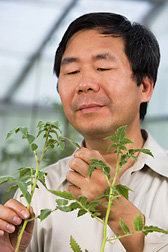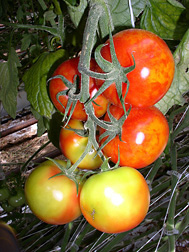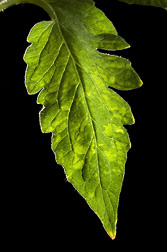Genetic Twists for Great Greenhouse Tomatoes
|
|
Backyard gardeners everywhere know the frustration of discovering that their once-flourishing tomato crop has begun a gentle—or not so gentle—decline.
Greenhouse tomato producers have profits as well as pride riding on their tomatoes. But tomato yields—and quality—have become increasingly vulnerable to a daunting new microbe, pepino mosaic virus (PepMV).
Kai-Shu Ling, an ARS plant pathologist with the U.S. Vegetable Laboratory in Charleston, South Carolina, is studying the origins and evolution of PepMV. Tomato growers are hopeful that Ling’s efforts will provide them with new ways to fight this threat.
“Kai-Shu is probably the world authority on PepMV right now,” says Michael Bledsoe, vice president of scientific and regulatory affairs for Village Farms in Longwood, Florida. Village Farms operates greenhouses for tomato production in Pennsylvania, Texas, and British Columbia.
|
|
PepMV infection is most noticeable in leaves, which exhibit a mosaic pattern with bright yellow spots. Marbled patterns sometimes develop in the tomato fruits, and the growth of the entire plant may be stunted. PepMV infection also makes plants more vulnerable to other pathogens.
The virus was first observed on pepino—a relative of the tomato—in Peru in 1980, followed by reports in 2000 of its occurrence in European tomatoes. It is now widespread in Europe, and is also found in North America, China, and Morocco.
The demand for greenhouse tomatoes, which now make up around 44 percent of the fresh retail tomato market, has grown tremendously over the past 20 years. In 2006 alone, some 652,000 metric tons of greenhouse tomatoes were produced in North America. Much of the U.S. production—30 percent of the North American total—is located in the Southwest.
In a greenhouse, PepMV can only be kept at bay with strict cleanliness and a constant watch to make sure that infected seeds or seedlings—which transmit the virus to healthy plants—are disinfected or kept away entirely.
Just a light touch can transmit PepMV from plant to plant, making the disease very contagious in a greenhouse once the virus has been introduced. Workers can inadvertently transmit the virus on tools—or even on their hands and clothes—from infected plants to healthy plants. Bumble bees, which are often used in greenhouse pollination, may also help spread the virus.
A Variety of Virus Strains
“When I started my research on PepMV, I looked first at the genetic makeup of the European strains,” Ling says. “These strains are almost genetically identical. They share more than 99 percent of the same nucleotide sequence in the genome, which strongly suggests they have a common ancestor.”
But two PepMV strains in the United States show a distinct divergence from the European varieties. So Ling began to study the genetic makeup of PepMV isolates carried on tomato seeds imported from South America to see whether he could tease out the relationships among the PepMV strains found in Europe, South America, and the United States.
When he examined the makeup of U.S. PepMV strains, he observed a strong similarity to the South American strains. One U.S. strain exhibited almost 99 percent of the same nucleotide sequence as a South American strain. Another U.S. strain shared almost 91 percent of its genetic traits with a different South American strain.
|
|
In contrast, South American and European PepMV strains did not exhibit the same degree of similarity. European strains only shared 78 percent to 86 percent of the genetic characteristics found in South American strains.
“I believe these results indicate a common origin for Chilean and U.S. types of PepMV,” Ling says. “The strain of PepMV that’s currently found in the United States was probably introduced accidentally into North America by tomato seeds produced in Chile.”
Ling also observed that tomato plants developed milder symptoms after infection with Chilean strains of PepMV than after exposure to the European strains. He believed he could use this information to develop a greenhouse tomato variety with either partial or complete resistance to PepMV. So he began to study different members of the Solanum genus—including several varieties of tomatoes—to see if he could find evidence for traits that could convey this kind of protection.
Genes at Work
In his first round of tests, Ling grew out 109 accessions of 5 different Solanum species, which he then inoculated with PepMV. Plants that developed no symptoms and showed little to no detectable levels of PepMV virus accumulation were saved for their seeds and for additional resistance tests.
A second round of tests included four types of S. habrochaites (a wild relative of tomato), which were used to develop offspring for more testing. A third round of cultivation was then carried out with the most robust plants from the second group.
Ling identified three S. habrochaites varieties that showed a range of genetic resistance to PepMV. He used the most robust of the three to generate new offspring, which remained symptom-free after exposure to a virus derived from Chilean PepMV strains.
Ling will now use this symptom-free variety to see whether he can create a tomato plant with genetic resistance to two different Chilean PepMV strains. If he’s successful, he’ll try to develop a tomato type that has a more general resistance to the European types of PepMV.
But there are other hurdles in the development of a PepMV-resistant—and commercially viable—variety of greenhouse tomato. “The disease-resistant variety of S. habrochaites produces a very small tomato fruit,” Ling notes. “So we need to figure out how to incorporate the disease-resistance gene without introducing the small-fruit trait.”
Ling thinks he’s headed in the right direction. Bledsoe says the entire greenhouse industry is counting on Ling’s future work.
“We’re spending a lot of money trying to keep this virus under control, but we’ll need all the help we can get,” Bledsoe notes. “Kai-Shu’s research is critical to the growing number of greenhouse tomato producers.”—By Ann Perry, Agricultural Research Service Information Staff.
This research is part of Plant Diseases, an ARS national program (#303) described on the World Wide Web at www.nps.ars.usda.gov.
Kai-Shu Ling is with the USDA-ARS U.S. Vegetable Laboratory, 2700 Savannah Highway, Charleston, SC 29414; phone (843) 402-5300, ext. 5313, fax (843) 573-4715.
"Genetic Twists for Great Greenhouse Tomatoes" was published in the September 2008 issue of Agricultural Research magazine.










